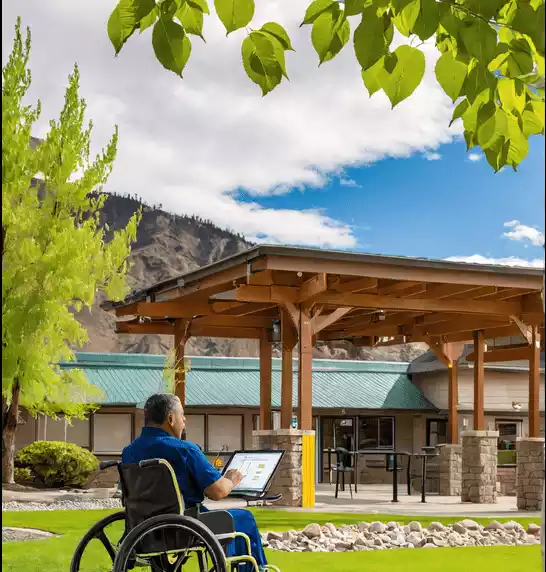Last updated on February 8th, 2025 at 04:05 pm
In today’s fast-paced world, inclusivity in the workplace is more important than ever. Assistive work technology plays a vital role in ensuring that individuals with disabilities can perform their jobs efficientlyandindependently. From adaptive hardware to AI-poweredsoftware, these tools help create a more equitable and productive work environment.

What Is Assistive Work Technology?
Assistive work technology refers to any tool, device, or software designed to support employees with disabilities in performing their job tasks effectively. These technologies bridge the accessibility gap, making workplaces more inclusive and fostering equal opportunities for all employees.
Types of Assistive Work Technology
1. Adaptive Computer Hardware
- Ergonomic Keyboards and Mice – Designed to reduce strain and improve ease of use for individuals with motor impairments.
- Screen Magnifiers – Help employees with visual impairments by enlarging on-screen text and images.
- Voice-Activated Controls – Enable hands-free navigation of digital devices, ideal for those with mobility challenges.
2. Assistive Software Solutions
- Screen Readers – Convert on-screen text into speech for visually impaired users.
- Speech-to-Text Software – Transcribes spoken words into written text, aiding those with dyslexia or motor impairments.
- AI-Powered Accessibility Features – Virtual assistants and AI-driven predictive text improve efficiency for employees with disabilities.
3. Mobility Aids for the Workplace
- Wheelchair-Accessible Desks and Workstations – Adjustable furniture ensures comfort and accessibility for wheelchair users.
- Smart Prosthetics and Exoskeletons – Enhance mobility and physical capabilities, allowing individuals to perform tasks with greater ease.
Benefits of Assistive Work Technology
1. Increased Workplace Productivity
Employees using assistive technologies can perform tasks more efficiently, leading to improved workflow and job performance.
2. Enhanced Independence
These technologies empower individuals to complete tasks independently, reducing the need for assistance and fostering self-reliance.
3. Greater Workplace Inclusivity
By integrating assistive tools, companies create an inclusive environment that supports a diverse workforce.
4. Compliance with Accessibility Regulations
Employers adopting assistive technology align with legal frameworks such as the Americans with Disabilities Act (ADA) and other workplace accessibility guidelines.
Challenges in Implementing Assistive Work Technology
Despite the benefits, organizations may face challenges in adopting assistive technology:
- High Costs – Advanced assistive tools may require significant investment.
- Lack of Awareness – Employers and employees may not be familiar with available assistive solutions.
- Integration Issues – Some assistive technologies may require compatibility adjustments with existing workplace systems.
How Employers Can Implement Assistive Work Technology
- Conduct Workplace Assessments – Identify specific needs of employees and evaluate available solutions.
- Invest in Employee Training – Ensure staff understands how to use assistive tools effectively.
- Consult with Accessibility Experts – Seek guidance from specialists to optimize workplace accessibility.
- Regularly Update Technology – Keep assistive tools up-to-date to improve functionality and effectiveness.
The Future of Assistive Work Technology
With advancements in AI, machine learning, and wearable technology, assistive work technology is evolving rapidly. Future innovations will likely enhance workplace accessibility through:
- Smarter AI Assistants – Personalized support tailored to individual employee needs.
- Enhanced Augmented Reality (AR) Solutions – Providing real-time guidance for visually impaired users.
- More Affordable Solutions – Increased affordability and accessibility of assistive tools for all workplaces.
FAQ Section
Q: What is the difference between assistive technology and adaptive technology?
A: While both terms refer to tools that help individuals with disabilities, assistive technology is generally broader, encompassing a wider range of devices and software. Adaptive technology is more specific, often referring to modifications made to existing products.
Q: How long does an assistive work technology assessment take?
A: The duration of the assessment can vary depending on individual needs and complexity. However, it typically involves several sessions to thoroughly evaluate and recommend appropriate solutions.
Q: Is there a cost associated with assistive work technology assessments?
A: The cost may vary depending on factors such as insurance coverage and the specific assistive technologies recommended. Please contact Roosevelt Warm Springs for more information.
Q: What types of assistive technology are available for people with visual impairments?
A: Common assistive technologies for people with visual impairments include screen readers, braille displays, and optical character recognition software.
Q: Can assistive technology help me find a job?
A: Yes, assistive technology can significantly improve your employability by providing the tools and support needed to perform your job effectively. Roosevelt Warm Springs can also assist with job placement services.
Conclusion
Assistive work technology is revolutionizing the modern workplace by ensuring that employees with disabilities can contribute effectively and independently. By embracing these innovations, companies not only enhance productivity but also foster a more inclusive and diverse workforce. Investing in assistive technologies is not just about compliance—it’s about empowering all employees to succeed.





